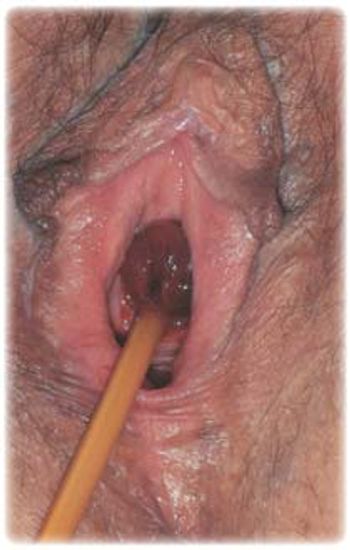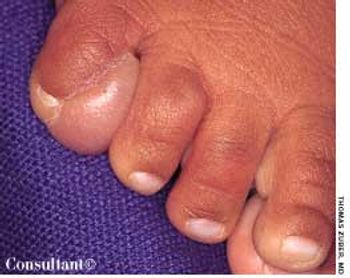
STOCKHOLM -- Smoking and human papillomavirus (HPV) may work together to increase the risk of cervical cancer in situ, according to researchers here.

STOCKHOLM -- Smoking and human papillomavirus (HPV) may work together to increase the risk of cervical cancer in situ, according to researchers here.

COPENHAGEN -- Testing for the human papilloma virus -- particularly in older women -- can be a valuable tool for predicting future cervical abnormalities and cancer, found researchers here.

ABSTRACT: Risk factors for oral cancer include tobacco use and alcohol intake (especially in conjunction with tobacco use). Many benign conditions may be confused with squamous cell carcinoma, the most common type of intraoral neoplasm. Any red and/or white lesion that has surface corrugation, stippling, or induration is considered dysplastic or neoplastic until proved otherwise. Even without these clinical signs, white plaques of any size that persist for several months may represent dysplasia. These lesions should be assessed by biopsy. Risk factors for lichen planus include stress, exposure to certain foods and medications, and systemic illness. Erosive lichen planus may cause significant pain and oral dysfunction.

ABSTRACT: Risk factors for oral cancer include tobacco use and alcohol intake (especially in conjunction with tobacco use). Many benign conditions may be confused with squamous cell carcinoma, the most common type of intraoral neoplasm. Any red and/or white lesion that has surface corrugation, stippling, or induration is considered dysplastic or neoplastic until proved otherwise. Even without these clinical signs, white plaques of any size that persist for several months may represent dysplasia. These lesions should be assessed by biopsy. Risk factors for lichen planus include stress, exposure to certain foods and medications, and systemic illness. Erosive lichen planus may cause significant pain and oral dysfunction.

This condition, also known as squamous cell carcinoma in situ, manifests in two thirds of patients as a solitary asymptomatic, slowly enlarging, erythematous, scaly 3-mm to 3-cm hyperkeratotic plaque that is crusted, fissured, or ulcerated.

An 80-year-old man has had an asymptomatic, flesh-colored swelling on his right ear for 4 to 5 months. In the center is a 1-mm white scab pointing downward from the helix. At times, the patient shaves a white spicule that grows in this crusted area. He sleeps on his right side and does not use a cell phone.

SACRAMENTO, Calif. -- Sexually active postmenopausal women who are not married or living as married may benefit from continued cervical cancer screening, researchers here reported.

SEATTLE -- The human papillomavirus has a long racial memory. So concluded researchers here, who found that variants of two carcinogenic HPV types tend to linger longer in women whose ancestors came from the same area where the variants first arose.

NEW YORK -- A dramatic increase in foot infections from unclean yoga mats, reported by a podiatrist last week, remains a mystery to other podiatrists who have seen no such increase.

A 51-year-old woman is seen because of burning at the site of entry of a urethral (Foley) catheter. The catheter had been placed perioperatively for a cholecystectomy. No history of genitourinary difficulty or trauma to the area. A urine culture that revealed Escherichia coli led to a diagnosis of urinary tract infection (UTI), but the relationship between this infection and the physical finding was unclear.

ATLANTA ? A vaccine against cervical cancer should be added to the list of recommended routine shots for girls ages 11 and 12, a federal public health panel has urged.

SEATTLE - Among newly sexually active women, consistent condom use by their partners reduced the risk of human papilloma virus (HPV) infection, researchers reported.

ROCKVILLE, Md. - The FDA today approved Gardasil (quadrivalent human papillomavirus [Types 6, 11, 16, 18] recombinant vaccine) for prevention of cervical cancer and for prevention of cervical, vulvar and vaginal pre-cancers caused by HPV types 16 and 18.

ATLANTA ? Gardasil (quadrivalent human papillomavirus [Types 6, 11, 16, 18]), the vaccine that is pending FDA approval for cervical cancer, is also 100% effective against HPV-related vaginal and vulvar lesions, researchers reported here.

Photo Quiz: Wart or Mimic? Part 2

Nongenital cutaneous warts--that is, common, plantar, filiform, and flat warts--are manifestations of the human papillomavirus (HPV). These warts are among the most common dermatologic complaints seen in primary care practices and are among the most common lesions treated by dermatologists.

During a routine examination, an asymptomatic wartlike lesion is noted near the axilla of a 35-year-old woman. The patient says that it has been present since childhood.

Telltale skin lesions of syphilis, gonorrhea, human papillomavirus infection, and Haemophilus ducreyi infection.

Telltale skin lesions of syphilis, gonorrhea, human papillomavirus infection, and Haemophilus ducreyi infection.

Telltale skin lesions of syphilis, gonorrhea, human papillomavirus infection, and Haemophilus ducreyi infection.

Telltale skin lesions of syphilis, gonorrhea, human papillomavirus infection, and Haemophilus ducreyi infection.

Telltale skin lesions of syphilis, gonorrhea, human papillomavirus infection, and Haemophilus ducreyi infection.

Telltale skin lesions of syphilis, gonorrhea, human papillomavirus infection, and Haemophilus ducreyi infection.

Telltale skin lesions of syphilis, gonorrhea, human papillomavirus infection, and Haemophilus ducreyi infection.

An enlarging mass was noted on the dorsum of the right fifth toe of a 2-month-old boy during a well-child examination. The firm, immobile mass measured approximately 1 cm in diameter. A congenital abnormality was suspected; the patient was referred to a plastic surgeon for consultation.